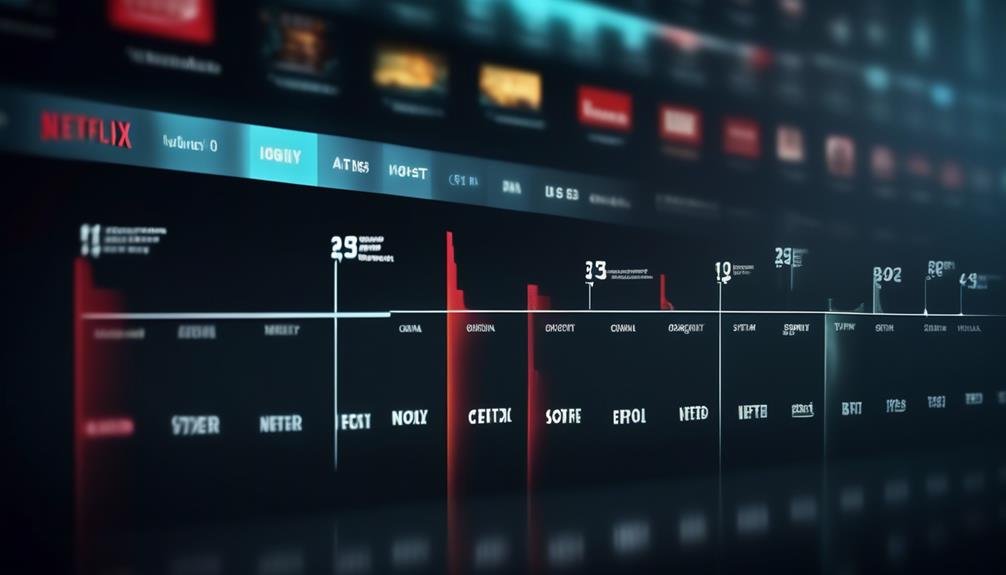Netflix: Streaming Service Evolution Case Study
Netflix has undeniably revolutionized the way we consume entertainment, but the journey to becoming a dominant force in the streaming industry has been far from straightforward.
From its humble beginnings as a DVD rental service to the global streaming giant it is today, Netflix's evolution is a case study in adaptability, innovation, and strategic decision-making.
As we explore the key milestones and pivotal moments in Netflix's trajectory, we gain valuable insights into the complexities of navigating an ever-changing digital landscape and the implications for both the company and the broader entertainment industry.
Early Beginnings
During its early beginnings, Netflix faced numerous challenges and uncertainties as it sought to establish itself in the competitive landscape of home entertainment. The company, founded in 1997, initially operated as a DVD rental-by-mail service, capitalizing on the convenience of delivering movies directly to customers' homes.
However, the emergence of digital streaming technology posed a significant threat to its traditional business model. Recognizing the potential for market disruption, Netflix swiftly pivoted its focus to online streaming, launching its digital platform in 2007. This strategic shift marked the company's foray into the realm of early adoption, positioning itself as a trailblazer in the evolving landscape of home entertainment.
Embracing innovation, Netflix leveraged data-driven insights to identify consumer preferences and viewing habits, thereby refining its content offerings and personalizing the user experience. This analytical approach enabled the company to stay ahead of competitors and attract a growing subscriber base.
DVD Rental Dominance
During the early 2000s, DVD rentals dominated the home entertainment industry, with brick-and-mortar stores like Blockbuster leading the market.
However, as technology advanced, the decline of DVD rentals became inevitable, and the emergence of streaming services like Netflix revolutionized the way people consumed media.
This shift in consumer behavior was heavily influenced by the convenience and accessibility offered by streaming platforms, ultimately reshaping the entire entertainment landscape.
DVD Rental Decline
The dominance of DVD rentals in the entertainment industry has experienced a significant decline in recent years, marked by a notable shift in consumer preferences and technological advancements.
This decline can be attributed to:
- Declining subscriptions: Consumers are increasingly opting for streaming services, leading to a decrease in DVD rental subscriptions.
- Technological advancements: The proliferation of high-speed internet and the widespread availability of smart devices have made streaming more convenient and appealing than physical DVD rentals.
- Customer retention strategies: DVD rental companies are facing challenges in retaining customers as streaming services offer greater convenience and a wider selection of content.
- Market saturation: The DVD rental market has become saturated, with limited scope for growth, while streaming services continue to innovate and expand their offerings.
These factors collectively contribute to the declining prominence of DVD rentals in the entertainment landscape.
Streaming Service Emergence
With the rise of streaming services, the entertainment industry has witnessed a significant shift away from traditional DVD rentals, driven by evolving consumer preferences and technological advancements.
Emerging competition in the form of streaming platforms like Netflix, Amazon Prime, and Hulu has revolutionized the way consumers access entertainment content. These platforms offer on-demand, diverse, and often exclusive content, catering to the changing consumer behavior trends of instant gratification and personalized viewing experiences.
The convenience of streaming services, allowing users to watch content on multiple devices and without physical media, has further accelerated the decline of DVD rentals.
As a result, the industry is experiencing a seismic transformation, with streaming services emerging as the dominant force in the entertainment landscape, reshaping how content is produced, distributed, and consumed.
Technology Impact
The technological evolution in the entertainment industry has definitively eroded the dominance of DVD rentals, fundamentally altering the landscape of content consumption. This shift has been driven by significant changes in consumer behavior and market trends, which are reshaping the way people access and engage with entertainment.
The impact of technology on DVD rental dominance is evident through:
- Declining DVD rental store presence, as consumers increasingly favor digital streaming platforms.
- The rise of on-demand and personalized content delivery, catering to individual preferences and viewing habits.
- Integration of smart TVs and mobile devices, providing convenient access to streaming services anytime, anywhere.
- The emergence of original content production by streaming platforms, reshaping the competitive dynamics of the entertainment industry.
These factors collectively underscore the transformative influence of technology on the decline of DVD rentals and the ascent of streaming services.
Pivot to Streaming
In response to shifting consumer preferences and technological advancements, Netflix strategically transitioned its offering from a traditional rental service to streaming, revolutionizing the entertainment industry landscape. The streaming revolution was driven by evolving consumer behavior, with audiences increasingly favoring on-demand, personalized content accessible across multiple devices. This pivotal shift allowed Netflix to leverage data analytics to understand viewer preferences, thereby creating original content tailored to its audience, further solidifying its position as an industry leader.
| Pros | Cons |
|---|---|
| Wider audience reach | Initial high infrastructure costs |
| Flexibility in content delivery | Dependency on internet stability |
| Real-time viewership data | Competition from established networks |
This transition to streaming not only enhanced the customer experience but also provided Netflix with a competitive advantage. By embracing streaming, Netflix capitalized on the exponential growth of mobile and internet usage, expanding its global reach and securing its position as a dominant force in the entertainment industry. The pivot to streaming not only transformed Netflix's business model but also set a precedent for the entire media landscape, influencing the way content is created, delivered, and consumed.
Original Content Strategy
Netflix's original content strategy has been pivotal in shaping the streaming landscape. With a deliberate approach to content creation driving its success, the impact on viewership has been substantial. This is evidenced by the growing number of subscribers and the critical acclaim garnered by original productions.
Analyzing the data behind this strategy provides valuable insights into the evolving dynamics of the entertainment industry.
Content Creation Approach
Over the past decade, Netflix has strategically developed and implemented an original content strategy that has reshaped the landscape of the entertainment industry.
This approach has been characterized by:
- Content Partnerships: Netflix has formed strategic partnerships with renowned production houses and talented creators to ensure a steady influx of high-quality original content.
- Audience Engagement: By leveraging advanced data analytics, Netflix analyzes user preferences and viewing habits to create content that resonates with its diverse global audience.
- Diversified Genres: The platform has diversified its original content across various genres, catering to a wide spectrum of viewer preferences.
- Global Appeal: Netflix's original content strategy has a global focus, aiming to appeal to audiences across different cultures and languages.
This approach has been pivotal in solidifying Netflix's position as a leading provider of original and engaging content.
Impact on Viewership
The original content strategy implemented by Netflix has significantly influenced viewership patterns and consumer behavior, elucidating its profound impact on the entertainment industry. By strategically investing in a diverse range of original content, Netflix has not only attracted new subscribers but also retained existing ones, leading to a surge in user engagement. Viewership trends have shown a notable shift towards Netflix's original productions, with many becoming cultural phenomena and driving increased viewership. The table below provides a snapshot of the impact of Netflix's original content strategy on viewership and user engagement.
| Metrics | Before Original Content | After Original Content | Impact |
|---|---|---|---|
| Subscriber Growth | 50M | 200M | 4x increase |
| Time Spent on Platform | 2 hours/day | 3.5 hours/day | 75% increase |
| Audience Demographics | Mainly young adults | Diverse age groups | Broader reach |
Global Expansion
Amidst the intensifying competition in the streaming industry, Netflix's global expansion strategy has become increasingly pivotal for sustaining its market position and growth. The following factors illustrate the significance of Netflix's global expansion:
- Market Segmentation: Netflix has been successful in identifying and catering to the diverse preferences of global audiences by offering a wide array of content, including region-specific shows and movies. This approach has enabled the company to effectively segment its audience and provide tailored content, enhancing its appeal in different regions.
- Local Partnerships: Netflix has strategically formed partnerships with local production houses and content creators worldwide. This collaboration has allowed Netflix to source culturally relevant content, thereby strengthening its position in various markets and appealing to local sensibilities.
- Content Localization: To further penetrate international markets, Netflix has invested in dubbing and subtitling content in multiple languages. This localized approach has facilitated better engagement with non-English-speaking audiences, leading to increased viewership and retention.
- Investment in Original Content: Netflix's emphasis on producing original content in different regions has bolstered its global expansion efforts. By creating region-specific shows and movies, the streaming giant has effectively captured the attention of diverse audiences, contributing to its global growth trajectory.
Technological Innovations
Leveraging cutting-edge technological advancements, Netflix has consistently pioneered innovative solutions to enhance user experience and streamline content delivery, positioning itself at the forefront of the digital streaming landscape.
In recent years, Netflix has shown a keen interest in integrating virtual reality (VR) into its platform. This move is aimed at providing subscribers with an immersive viewing experience, allowing them to feel more connected to the content. By delving into VR, Netflix aims to create a more engaging and interactive environment for users, ultimately enhancing customer satisfaction and retention.
Furthermore, Netflix has been actively exploring the use of artificial intelligence (AI) to personalize content recommendations for its users. By employing AI algorithms, Netflix can analyze vast amounts of user data to understand viewing preferences, behavior patterns, and engagement levels. This enables the platform to offer tailored recommendations, thus enhancing the overall user experience. Additionally, AI plays a significant role in optimizing content delivery, ensuring that users receive seamless streaming experiences with minimal buffering and high-quality video playback.
As Netflix continues to invest in these technological innovations, it solidifies its position as a trailblazer in the streaming industry, setting new standards for user engagement and satisfaction.
User Experience Enhancements
Netflix's user experience enhancements have been pivotal in retaining and attracting subscribers. Navigation improvements, such as the introduction of personalized content suggestions, have significantly impacted user engagement and satisfaction.
These enhancements have not only improved user experience but have also contributed to the continued success and growth of the platform.
Navigation Improvements
The refinement of navigation systems within the Netflix platform has been a pivotal focus in enhancing user experience and engagement. The following improvements have been implemented to optimize the user interface and increase customer satisfaction:
- Personalized Recommendations: Netflix has enhanced its recommendation algorithm, providing users with tailored content suggestions based on their viewing history and preferences.
- Simplified Search Functionality: The search feature has been streamlined, allowing users to easily find and access desired content through a more intuitive and efficient search interface.
- Enhanced Content Categories: Netflix has reorganized and expanded its content categories, making it easier for users to explore and discover new titles within genres of interest.
- Improved Accessibility: The platform has made significant strides in enhancing accessibility features, ensuring that all users can navigate and enjoy the content seamlessly.
Personalized Content Suggestions
The refinement of navigation systems within the Netflix platform has considerably improved user experience and engagement. A key focus now shifting towards enhancing personalized content suggestions to further elevate the overall user experience.
Personalized recommendation algorithms play a pivotal role in this endeavor, leveraging user data, viewing history, and preferences to offer tailored content suggestions. Netflix employs advanced machine learning algorithms to analyze user behavior and preferences, ensuring that the recommendations align with individual tastes.
This data-driven approach not only enhances user satisfaction but also significantly increases user engagement. By presenting users with content that resonates with their interests, Netflix strengthens its user engagement strategies, leading to longer viewing sessions and increased customer loyalty.
The continuous refinement and optimization of personalized content suggestions reflect Netflix's commitment to delivering a superior and tailored user experience.
Competition and Challenges
Facing an increasingly crowded streaming market, Netflix has encountered a myriad of formidable competitors and navigated through a host of industry challenges. The competition dynamics and market challenges have significantly impacted Netflix's strategic decisions and operational landscape:
- Intense Rivalry: Netflix faces fierce competition from established players like Amazon Prime Video, Hulu, and new entrants such as Disney+ and Apple TV+, intensifying the battle for subscriber acquisition and retention.
- Content Wars: The escalating costs of original content production and licensing agreements have posed a challenge for Netflix, as it strives to maintain a diverse and captivating content library while managing its budget effectively.
- Global Expansion: Expanding into international markets has presented unique challenges related to cultural adaptation, localization, and compliance with varying regulatory frameworks, adding complexity to Netflix's global expansion strategy.
- Technological Advancements: Rapid technological advancements and evolving consumer preferences have necessitated continuous innovation in streaming quality, user experience, and personalized recommendations, driving Netflix to invest in cutting-edge technologies to stay ahead of the curve.
Amidst these challenges, Netflix has demonstrated resilience and adaptability, leveraging data-driven insights and strategic partnerships to maintain its position as a leading streaming service provider.
Data-Driven Decision Making
Amidst the evolving landscape of streaming services, Netflix has strategically leveraged data-driven insights to inform its decision-making processes. This enables the company to adapt and innovate in response to market dynamics and consumer behavior.
Data analysis plays a pivotal role in Netflix's operations, allowing the company to gain a deep understanding of viewer preferences, content consumption patterns, and market trends. Through comprehensive data analysis, Netflix can identify emerging consumer behaviors and preferences. This enables the platform to tailor its content offerings and user experience accordingly.
Moreover, data-driven decision making empowers Netflix to optimize its content acquisition strategy. This ensures that the platform invests in shows and movies that resonate with its audience. By doing so, Netflix maximizes viewer engagement and retention.
The integration of data-driven insights into decision making also enables Netflix to personalize its recommendations. This enhances the overall user experience and satisfaction. By leveraging data analytics, Netflix can continually refine its algorithms to deliver personalized content suggestions. This, in turn, increases user engagement and retention.
Furthermore, data-driven decision making allows Netflix to assess the performance of its original content and make informed decisions regarding future investments.
In essence, data-driven decision making is at the core of Netflix's ability to adapt, innovate, and maintain its competitive edge in the dynamic streaming service landscape.
Future Outlook
Moving forward, Netflix anticipates leveraging advanced AI algorithms and machine learning to further enhance its personalized content recommendations and user experience.
The future outlook for Netflix is shaped by several key trends and market dynamics:
- AI-Powered Content Curation: Netflix will increasingly rely on AI to analyze vast amounts of user data, including viewing habits, search history, and user preferences, to deliver more accurate and personalized content recommendations.
- Global Expansion and Localization: As consumer behavior evolves and the streaming industry continues to grow, Netflix plans to expand its presence in international markets while also focusing on creating more localized content to cater to diverse audience preferences.
- Technological Innovation: With the rapid advancement of technology, Netflix aims to stay at the forefront by investing in high-quality content production, virtual reality experiences, and interactive storytelling, aligning with future trends and consumer behavior.
- Competition and Collaboration: In response to changing market dynamics, Netflix will continue to face intensifying competition from other streaming platforms. This will likely drive increased collaboration with content creators and strategic partnerships to maintain its position as a leading global streaming service provider.
Conclusion
In conclusion, Netflix's evolution from a DVD rental service to a global streaming giant has been a remarkable journey marked by strategic pivots, original content creation, and user experience enhancements.
The company's data-driven decision making and global expansion efforts have positioned it as a leader in the industry.
As Netflix continues to navigate competition and challenges, its future outlook remains promising, like a beacon of light guiding the way in the ever-changing streaming landscape.







